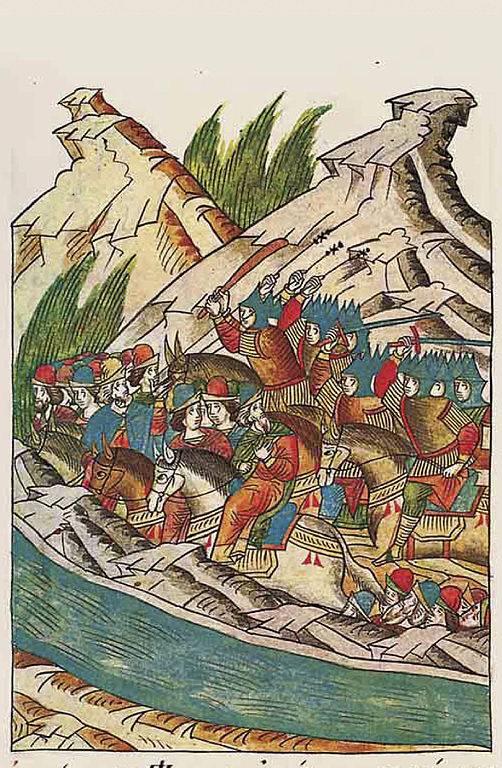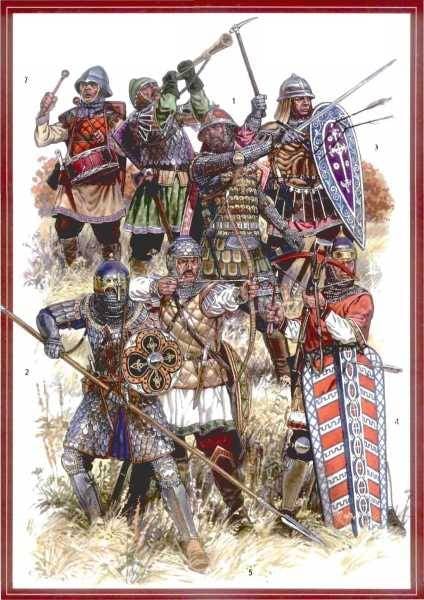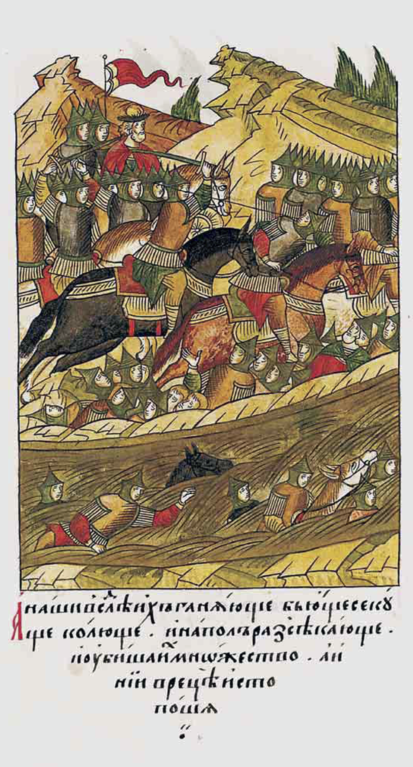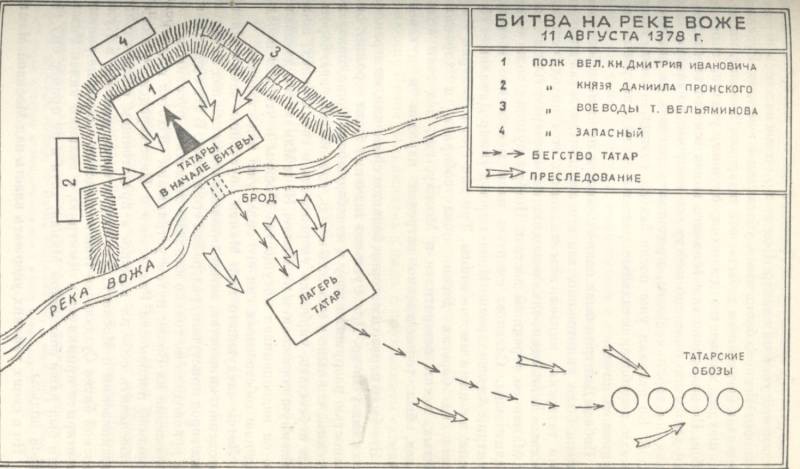The victory of the Russian army in the battle of the river Vozhe
Before the war
In the second half of the 14th century, the Mongolian empire became an extremely loose state entity that lost its internal unity. The decline of the Yuan Empire, which was ruled by the descendants of Kublai, and of Hulaguid Iran, began. Ulus Chagatai burned out in an incessant civil war: over the 70 years, more than twenty khans changed there, and only under Timur, order was restored. Ulus Juchi, consisting of White, Blue and Golden Horde, which included a significant part of Russia, was also not in the best position.
During the reign of Khan Uzbek (1313 — 1341) and his son Janibek (1342 — 1357), the Golden Horde reached its peak. However, the adoption of Islam by the state religion led to the erosion of the imperial organism. Riots of princes, who refused to accept Islam, began, they were cruelly crushed. At the same time, the majority of the population of the Horde (like the Russians, they were Europoids, descendants of Great Scythia), remained loyal to the old pagan faith for a long time. Thus, in the “Tale of Mamayev’s Battle”, a 15th-century Moscow monument, the gods worshiped by the Horde “Tatars” are mentioned: Perun, Salavat, Reclius, Horse, Mohammed. That is, the ordinary Horde still continued to praise Perun and Hors (the Slavic-Russian gods). The total Islamization and the influx into the Golden Horde of a huge number of Arabs were the causes of the degradation and collapse of a powerful empire. A century later, the Islamization of the Horde will divide the heirs of the Great Scythia. The Islamized Eurasian part of the “Tatars” will be cut off from the super-ethnos of the Rus, will fall under the authority of the hostile Russian civilization of the Crimean Khanate and Turkey. Only after the reunification of the main part of the territory of the empire will the process of restoring unity begin, and the Russians and Tatars will become the state-forming ethnic groups of the new Russian empire-horde.
Since 1357, in the Horde, after the killing of Khan Janibek by his son Berdibek, who himself was killed a little more than a year later, "great confusion" began - a continuous series of coups and shifts of the Khans, who often ruled no more than a year. With the death of Berdibek, the Batu dynastic line died away. With the death of Khan Temir-Khoja, killed by the dark mamai, married to his sister Berdibek, the Ulus Juchi actually collapsed. Mamai and his “hand-made” Khan Abdullah entrenched on the right bank of the Volga. Horde finally split into several independent possessions.
The White Horde maintained its unity. Its ruler, Urus Khan, led the warrior for the reunification of the Juchi ulus and successfully defended his borders against Timur’s attempts to extend his influence north of the Syr Darya. One day, as a result of a conflict with Urus Khan, the ruler of Mangyshlak Tui-Khoja-Oglan lost his head, and his son Tokhtamysh, the prince from the house of Chingizids, was forced to flee to Tamerlane. Tokhtamysh led the war for his inheritance unsuccessfully, until in 1375, Urus-khan did not die, and the following year Tokhtamysh easily mastered the White Horde. The policy of Tokhtamysh continued the strategy of Urus-Khan, and it is based on the task of restoring the Juchi ulus. His most powerful and implacable opponent was Mamai, the lord of the right bank of the Volga and the Black Sea. In his struggle for power in the Horde, Mamai sought to rely on both Russia and the Russian-Lithuanian Grand Duchy. However, the union was fragile.
Moscow Rus
In 1359, the Grand Duke of Moscow, Ivan Ivanovich Krasny, died; he was inherited by a son, ten years old, Dmitry. Moscow by that time, thanks to the efforts of its predecessors, Dmitry Ivanovich, occupied one of the most important places among other Russian principalities and lands. In 1362, at the price of complicated intrigues, Dmitry Ivanovich receives a label for the great reign of Vladimir. A label for reigning was issued to the young prince Dmitry, who ruled Khan Murug at that moment in Sarai. True, the right to reign was still to be won from the Suzdal-Nizhny Novgorod prince Dmitry, who had received the exact same label several times before. In 1363, a successful march took place, during which Dmitri subdued Vladimir.
Then Tver got in the way of Moscow. The rivalry of the two Russian centers resulted in a whole series of wars, where Tver against the dangerously strengthened neighbor was supported by the Prince of Lithuania Olgerd. From 1368 to 1375, Moscow continuously fought Tver and Lithuania, and Novgorod joined the war. As a result, when in the 1375 year after a month-long siege of the land of Tver were devastated, and Lithuanian troops did not dare to attack the Moscow-Novgorod rati, Prince Mikhail of Tver was forced to accept the world dictated to him, where he recognized himself as “younger brother” Ivanovich and in fact obeyed the Moscow prince.
In the same period, when the Horde was in turmoil, the Russian princes stopped paying tribute. In 1371, Mamai gave Moscow Prince Dmitry a label for a great reign. For this, Dmitry Ivanovich agreed to pay the “Horde way out” again. In December of the same year, the Moscow army under the command of Dmitry Bobrok Volynsky opposed Ryazan and defeated the Ryazan army. However, the emerging alliance between Moscow and the Golden Horde destroyed the assassination of ambassadors Mamai in Nizhny Novgorod, committed in 1374 at the instigation of the Suzdal bishop Dionysius, close to Dmitry of Moscow, and the new refusal of Moscow to pay tribute to the Horde.
As a result, from this moment on, Moscow finds itself in a situation of military confrontation with the Horde. In the same year, 1374, Mamai is taking a trip to Nizhny Novgorod lands. In 1376, Mamai again attacks Nizhny Novgorod. The Moscow army advances to the city, having learned about the approach of which, the Horde departs. In the winter from 1376 to 1377, the Moscow and Suzdal-Nizhniy Novgorod rati, under the command of Dmitry Bobrok, undertook a successful campaign against the Kama Bulgars. In March, 1377, on the approaches, according to some researchers, to Kazan, a decisive battle took place, where the Bulgars were defeated. According to some reports, both sides used firearms. weaponhowever without much success. One of the Horde lands was subordinated to Moscow: here the Russian governors left the Moscow governor and duty collectors.
However, in 1377, the Horde struck back. 2 August, Prince Arapsha, commander Mamaia, destroyed the Russian army on the River Piana, which defended the eastern borders of Russia and consisted of Nizhny Novgorod, Vladimir, Pereyaslav, Murom, Yaroslavl and Yuryev people. Then the Horde took and burned Nizhny Novgorod, which was left unprotected. After that, the Horde invaded Ryazan and defeated it. The Prince of Ryazan, Oleg Ivanovich, barely managed to escape.

Battle of Drunk. Facial Chronicle
The Russian Army
The army played a major role in the victories of Moscow during this period. Dmitri Ivanovich was able to organize a serious and efficient army. The Russian army of the XIV century was a feudal army, where the territorial principle was the basis of the organization. That is, in the case of military necessity, the Grand Duke (overlord) convened under his banner all his vassals, according to the principalities, cities, inheritances and patrimonies. Russian consisted of such units, recruited on a territorial basis, it included the unit princes, boyars, nobles, boyar children, approximate feudal lords, free servants and city militias. Detachments were commanded by large and medium feudal lords (boyars and princes). Service in the army at this time becomes mandatory, discipline is growing, and, most importantly, a more precise organization of the army itself and its management. The smallest units were “spears”, that is, the commander was a notable warrior, and several fighters subordinate to him, only about 10 people. Several dozen "copies" were united in the "banner", that is, a larger unit, which was under the command of the boyars or small princes. The number of Russian "banners" was from 500 to 1500 people. The "banner" had its own, unique banner, according to which the unit could easily be found in the thick of the battle. The Стstyles ’could perform independent tasks and be part of larger units: from стtyagi’ (from 3 to 9) formed regiments led by princes and voivods. There were several regiments (like Horde tumens) - the Big Regiment, the regiments of the Left and Right Hands (this was the traditional division of the Russian army), they also formed the Front and Guard Regiments.
An important role in organizing the Russian ratification was played by Moscow’s previous diplomatic efforts. According to the treaties of the time, first the inheritances, and then the principalities independent of Moscow, were obliged to act together with the Moscow Grand Duchy against the common enemy. “And who will be our oldest foe, then we will be a foe, and who will be our oldest friend’s brother, then we will be our friend,” was the usual formula for such “finishing”. And, from here - “will you send us, carry you on a horse without disobedience”. The 1375 war with Tver ended with just such an agreement, and both grand dukes were required to take part in joint campaigns. In the course of the same campaign (against Tver), Moscow conducted such a mobilization: as a part of the joint ratification, the troops of Serpukhov-Borovsk, Rostov, Yaroslavl, Suzdal, Bryansk, Kashinsky, Smolensk, Obolensky, Molozhsky, Tarusa, Novosilsky, Gordetsky and Starodubovsky principalities came forward. According to the contract, Novgorod also set up its army. According to the chronicles, a total of 22 detachments, which, apparently, were combined into several regiments, appeared on Tver. Already during the march on Tver, the troops assembled by the Grand Duke of Moscow had a single command. Such a commander was the grand duke, at the behest of which the united army of the Russian principalities was going to. It is possible that during the same period, military paintings were created - “discharges”, which regulated the number of troops, their weapons, construction, governor.
At the same time, a peculiar revival of infantry is taking place in Russia. Dense infantry formations, bristling with a hedgehog of copies, relying on the support of archers and crossbowmen in the back ranks have become a formidable force capable of stopping the enemy cavalry and giving their cavalry time to organize a counterattack. 1 — 2 lines of construction were occupied by heavily armed warriors, armed with a long spear with a long leaf-shaped tip, a sword and a dagger, a shield, scaly armor with mounts and bibs, and a quality helmet. 3 — The 4 line was occupied by medium-armed warriors, weapons — a sword, a combat knife and an ax, a hammer or a war hammer, a shield and protective armor. At the beginning of the battle in the first line, and during the attack of the enemy in 5 and 6, archers and crossbowmen marched.
Remote combat weapons during the 14th century play an increasingly important role in the conduct of hostilities. Crossbowmen and archers during the battle of the Vozhe and the Kulikovo battle played a fairly significant role in the Russian regiments. Armed with crossbowmen was the simplest crossbow, loaded with stirrup and belt hook. From the other weapons of the warriors - a cleaver, an ax and a long combat knife. Crossbow arrows bolts were stored in a leather quiver suspended from a belt. The warrior's head was protected by a spherical conical helmet, the body is covered with scaly armor with a hem and braids, over which a short jacket is worn with short, elbow-length sleeves. On the knees - protective plates. Of great importance in the complex armament of the crossbowman played a large shield with a vertical chute. The crossbowman could not only completely hide behind such a shield, but also use it as an emphasis for shooting. The role of archers in the Russian army at this time was not only preserved, but also increased.

Russian infantry: 1 - dismounted commander, 2 - heavily armed footchanger, 3 - medium-armed infantryman, 4 - crossbowman, 5 - archer, 6 - trumpeter, 7 - drummer. Source: A. Shcherbakov. Battle of Kulikovo
Battle of the Chest
The Horde in the spring of 1378, undertook a new punitive expedition and on July 24 defeated Nizhny Novgorod again. Prince Dmitry Konstantinovich closed in Gorodets and vainly begged for peace. Then Mamai, having received reinforcements, crossed the Volga and invaded the borders of the Ryazan principality. Horde took and burned Pronsk, stormed Ryazan. Ryazan region again washed with blood. It seemed that the new invasion of Batu began, and other lands would follow Ryazan.
Dmitry Ivanovich understood the danger, personally podpdel with his army on the southern side of the Oka and met the Tatars on the banks of its right tributary, the River Legends, versts in 15 from Pereyaslavl-Ryazan. For several days both troops stood against each other on different banks. Horde feared start crossing. The Moscow prince, in order to lure the enemy into a previously prepared trap, began to withdraw his troops from the river (gave breg). 11 August 1378 Horde crossed I drive and join the battle. But Dmitry has already made his army for the battle. In the center, in the depths of the forest, a moat and a rampart prepared, here stood infantry and crossbowmen, who stopped the onslaught of the enemy cavalry. On the wings were heavily armed squads. One wing was commanded by Daniel Pronsky, the other by the Moscow okolnichy Timofey Vel'yaminov. The Grand Duke himself also launched a counterattack with the main regiment. As a result, the outcome of the case was decided by a sudden strike by the regiments of the right and left hand on the flanks of the Horde army. In this case, the Horde were deprived of maneuver because of the forest fortified by abutments and swamps on the flanks, and in the rear was a river. The Horde people could not stand the direct battle and ran back to drive: "... and our people began to pursue them, chopping and pricking, and a great many killed them, and many of them drowned in the river." And on the river they were met by the Russian ship party.
It was a complete rout. Among the fallen was Begich himself and some other notable Murza and his temniki (the commanders of the cavalry corps): Khazibey, Koverga, Karuluk, Kastrok. That is, the enemy's army was almost completely destroyed - according to tradition, the Horde commanders themselves tried not to join the battle, commanding from a safe place. And here all the leading commanders died. The night came prevented the persecution by the Russians. The morning after the battle of Voge there was a thick fog. Only when he dispersed, Dmitri crossed the river and chased the remaining enemies. It was impossible to overtake them. The Russian warriors collected large booty, because the enemies in a hasty flight abandoned their tents and carts filled with various good things. The monument to the battle of Voge 1378 is the high burial mounds, under which fallen warriors are buried.
It was the first big victory of Russia over the Horde. An open and decisive uprising of the Moscow prince against the Golden Horde began, which led to the Kulikovo battle, and then the defeat of Moscow Tokhtamysh. Mamai began to gather a huge army to punish Moscow and repeat Batu's invasion. On the other hand, Mom had to repel the threat from Tokhtamysh. Thus, the participants of the big war were determined: on the one hand, Mamai and Lithuania, claiming Russian lands, on the other, rising against the usurper Tokhtamysh, trying to restore the unity of the Horde and opposing the same Mamaia Moscow and Russian lands to it.
It is worth noting that during this period the mass transition of ordinary Horde (Cossack) with their Murzians and princes to the side of Russia (in particular, Ryazan and Moscow) begins. The Islamized elite of the Horde lost the support of a significant part of the population. Orthodoxy, which absorbed much of the ancient Russian faith (the period of dual faith ended with the synthesis of Christianity and Russian paganism), turned out to be closer to ordinary Horde people than foreign Islam. The process of the formation of a new center of many thousands of northern civilizations began - from Hyperborea and Aria, Great Scythia to the Russian-Horde empire and the Russian kingdom-empire (the Soviet empire continued this tradition). Moscow for a century and a half will restore the main core of the empire (Horde), and Ivan Vasilyevich the Terrible will be the first Russian emperor.

Battle of the Voge 1378 River. Miniature of the second half of the 16th century

Information